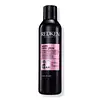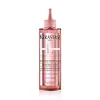What's inside
What's inside
 Key Ingredients
Key Ingredients

 Benefits
Benefits

 Concerns
Concerns

 Ingredients Side-by-side
Ingredients Side-by-side

Water
Skin ConditioningPropylene Glycol
HumectantHydrogen Peroxide
AntimicrobialOleyl Alcohol
EmollientPPG-2 Butyl Ether
Skin ConditioningLaureth-2
CleansingSodium C14-16 Olefin Sulfonate
CleansingPEG/PPG-4/12 Dimethicone
EmulsifyingCocamide Mipa
EmulsifyingAmodimethicone
Glycerin
HumectantPrunus Armeniaca Kernel Oil
MaskingParfum
MaskingDimethicone
EmollientCitric Acid
BufferingCarbomer
Emulsion StabilisingEthanolamine
BufferingLauryl Alcohol
EmollientPPG-5-Ceteth-10 Phosphate
EmulsifyingSodium Sulfite
PreservativeTaurine
BufferingCoco-Betaine
CleansingGuar Hydroxypropyltrimonium Chloride
Skin ConditioningMyristyl Alcohol
EmollientLimonene
PerfumingTrideceth-10
CleansingTrideceth-6
EmulsifyingTetrasodium Etidronate
Emulsion StabilisingSodium Chloride
MaskingTetrasodium Pyrophosphate
BufferingLinalool
PerfumingSodium Salicylate
PreservativeTetrasodium Glutamate Diacetate
Cetyl Alcohol
EmollientSodium Citrate
BufferingBenzyl Salicylate
PerfumingPEG-100 Stearate
Steareth-6
EmulsifyingCetrimonium Chloride
AntimicrobialBenzoic Acid
MaskingBenzyl Alcohol
PerfumingAlpha-Isomethyl Ionone
PerfumingTrideceth-3
EmulsifyingGlycine Soja Oil
EmollientArginine
MaskingSerine
MaskingTocopherol
AntioxidantGlutamic Acid
HumectantPhenoxyethanol
PreservativeTetrasodium EDTA
Acetic Acid
BufferingPentaerythrityl Tetra-Di-T-Butyl Hydroxyhydrocinnamate
AntioxidantWater, Propylene Glycol, Hydrogen Peroxide, Oleyl Alcohol, PPG-2 Butyl Ether, Laureth-2, Sodium C14-16 Olefin Sulfonate, PEG/PPG-4/12 Dimethicone, Cocamide Mipa, Amodimethicone, Glycerin, Prunus Armeniaca Kernel Oil, Parfum, Dimethicone, Citric Acid, Carbomer, Ethanolamine, Lauryl Alcohol, PPG-5-Ceteth-10 Phosphate, Sodium Sulfite, Taurine, Coco-Betaine, Guar Hydroxypropyltrimonium Chloride, Myristyl Alcohol, Limonene, Trideceth-10, Trideceth-6, Tetrasodium Etidronate, Sodium Chloride, Tetrasodium Pyrophosphate, Linalool, Sodium Salicylate, Tetrasodium Glutamate Diacetate, Cetyl Alcohol, Sodium Citrate, Benzyl Salicylate, PEG-100 Stearate, Steareth-6, Cetrimonium Chloride, Benzoic Acid, Benzyl Alcohol, Alpha-Isomethyl Ionone, Trideceth-3, Glycine Soja Oil, Arginine, Serine, Tocopherol, Glutamic Acid, Phenoxyethanol, Tetrasodium EDTA, Acetic Acid, Pentaerythrityl Tetra-Di-T-Butyl Hydroxyhydrocinnamate
Alcohol Denat.
AntimicrobialPropylene Glycol
HumectantWater
Skin ConditioningCaprylic/Capric Triglyceride
MaskingMyristyl Alcohol
EmollientCetearyl Alcohol
EmollientCetrimonium Chloride
AntimicrobialBehentrimonium Methosulfate
Parfum
MaskingLactic Acid
BufferingPEG-14 Dimethicone
Skin ConditioningPPG-10 Methyl Glucose Ether
Skin ConditioningDi-C12-13 Alkyl Malate
EmollientTocopherol
AntioxidantTartaric Acid
BufferingLinalool
PerfumingLimonene
PerfumingGeraniol
PerfumingCentella Asiatica Extract
CleansingPentaerythrityl Tetra-Di-T-Butyl Hydroxyhydrocinnamate
AntioxidantCeramide AP
Skin ConditioningAlcohol Denat., Propylene Glycol, Water, Caprylic/Capric Triglyceride, Myristyl Alcohol, Cetearyl Alcohol, Cetrimonium Chloride, Behentrimonium Methosulfate, Parfum, Lactic Acid, PEG-14 Dimethicone, PPG-10 Methyl Glucose Ether, Di-C12-13 Alkyl Malate, Tocopherol, Tartaric Acid, Linalool, Limonene, Geraniol, Centella Asiatica Extract, Pentaerythrityl Tetra-Di-T-Butyl Hydroxyhydrocinnamate, Ceramide AP
Ingredients Explained
These ingredients are found in both products.
Ingredients higher up in an ingredient list are typically present in a larger amount.
This ingredient is a preservative, antimicrobial, and emulsifier. It is often used in cosmetics for its ability to cleanse, condition, and reduce static.
Cetrimonium chloride is a quaternary ammonium salt, meaning it has a water-soluble structure.
Limonene is a fragrance that adds scent and taste to a formulation.
It's found in the peel oil of citrus fruits and other plants such as lavender and eucalyptus. The scent of limonene is generally described as "sweet citrus".
Limonene acts as an antioxidant, meaning it helps neutralize free radicals.
When exposed to air, oxidized limonene may sensitize the skin. Because of this, limonene is often avoided by people with sensitive skin.
The term 'fragrance' is not regulated in many countries. In many cases, it is up to the brand to define this term. For instance, many brands choose to label themselves as "fragrance-free" because they are not using synthetic fragrances. However, their products may still contain ingredients such as essential oils that are considered a fragrance.
Learn more about LimoneneLinalool is a fragrance and helps add scent to products. It's derived from common plants such as cinnamon, mint, citrus, and lavender.
Like Limonene, this ingredient oxidizes when exposed to air. Oxidized linalool can cause allergies and skin sensitivity.
This ingredient has a scent that is floral, spicy tropical, and citrus-like.
Learn more about LinaloolMyristyl Alcohol is type of fatty alcohol. It is a white, waxy solid and insoluble in water.
As an emollient, it hydrates the skin by trapping moisture in.
Fatty Alcohols are most often used as an emollient or to thicken a product. They are usually derived from natural fats and oils and therefore do not have the same drying or irritating effect as solvent alcohols.
Learn more about Myristyl AlcoholParfum is a catch-all term for an ingredient or more that is used to give a scent to products.
Also called "fragrance", this ingredient can be a blend of hundreds of chemicals or plant oils. This means every product with "fragrance" or "parfum" in the ingredients list is a different mixture.
For instance, Habanolide is a proprietary trade name for a specific aroma chemical. When used as a fragrance ingredient in cosmetics, most aroma chemicals fall under the broad labeling category of “FRAGRANCE” or “PARFUM” according to EU and US regulations.
The term 'parfum' or 'fragrance' is not regulated in many countries. In many cases, it is up to the brand to define this term.
For instance, many brands choose to label themselves as "fragrance-free" because they are not using synthetic fragrances. However, their products may still contain ingredients such as essential oils that are considered a fragrance by INCI standards.
One example is Calendula flower extract. Calendula is an essential oil that still imparts a scent or 'fragrance'.
Depending on the blend, the ingredients in the mixture can cause allergies and sensitivities on the skin. Some ingredients that are known EU allergens include linalool and citronellol.
Parfum can also be used to mask or cover an unpleasant scent.
The bottom line is: not all fragrances/parfum/ingredients are created equally. If you are worried about fragrances, we recommend taking a closer look at an ingredient. And of course, we always recommend speaking with a professional.
Learn more about ParfumPentaerythrityl Tetra-Di-T-Butyl Hydroxyhydrocinnamate (long name, huh?) is a synthetic antioxidant.
It is used to help stabilize other antioxidants or prevent the color from changing in a product.
As an antioxidant, it helps fight free-radical molecules. Free-radical molecules are capable of damaging our cells and other genetic material. Thus, antioxidants may reduce the signs of aging.
This ingredient is oil-soluble.
Learn more about Pentaerythrityl Tetra-Di-T-Butyl HydroxyhydrocinnamatePropylene Glycol is an odorless, colorless liquid. As a humectant, it helps skin retain moisture. It also aids in delivering active ingredients.
Another role of this ingredient is preventing a product from melting or freezing. Propylene glycol also adds antimicrobrial properties to a product, elongating product lifespan.
This ingredient is considered an organic alcohol and commonly added into both cosmetics and foods.
Those with sensitive skin or conditions may develop a rash when using this ingredient.
Learn more about Propylene GlycolTocopherol (also known as Vitamin E) is a common antioxidant used to help protect the skin from free-radicals and strengthen the skin barrier. It's also fat soluble - this means our skin is great at absorbing it.
Vitamin E also helps keep your natural skin lipids healthy. Your lipid skin barrier naturally consists of lipids, ceramides, and fatty acids. Vitamin E offers extra protection for your skin’s lipid barrier, keeping your skin healthy and nourished.
Another benefit is a bit of UV protection. Vitamin E helps reduce the damage caused by UVB rays. (It should not replace your sunscreen). Combining it with Vitamin C can decrease sunburned cells and hyperpigmentation after UV exposure.
You might have noticed Vitamin E + C often paired together. This is because it is great at stabilizing Vitamin C. Using the two together helps increase the effectiveness of both ingredients.
There are often claims that Vitamin E can reduce/prevent scarring, but these claims haven't been confirmed by scientific research.
Learn more about TocopherolWater. It's the most common cosmetic ingredient of all. You'll usually see it at the top of ingredient lists, meaning that it makes up the largest part of the product.
So why is it so popular? Water most often acts as a solvent - this means that it helps dissolve other ingredients into the formulation.
You'll also recognize water as that liquid we all need to stay alive. If you see this, drink a glass of water. Stay hydrated!
Learn more about Water